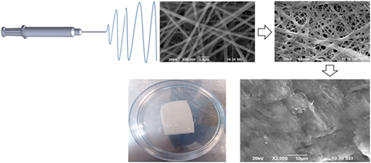Crossref Citations
This article has been cited by the following publications. This list is generated based on data provided by
Crossref.
Muniz, Nathália O.
Vechietti, Fernanda A.
Anesi, Guilherme R.
Guinea, Gustavo V.
and
dos Santos, Luís Alberto L.
2020.
Blend-based fibers producedviacentrifugal spinning and electrospinning processes: Physical and rheological properties.
Journal of Materials Research,
Vol. 35,
Issue. 21,
p.
2905.
Terrell, John A.
Jones, Curtis G.
Kabandana, Giraso Keza Monia
and
Chen, Chengpeng
2020.
From cells-on-a-chip to organs-on-a-chip: scaffolding materials for 3D cell culture in microfluidics.
Journal of Materials Chemistry B,
Vol. 8,
Issue. 31,
p.
6667.
Xu, Yongjing
Liu, Bo
Zou, Liming
Sun, Chenkai
and
Li, Wengang
2020.
Preparation and characterization of PLLA/chitosan-graft-poly (ε-caprolactone) (CS-g-PCL) composite fibrous mats: The microstructure, performance and proliferation assessment.
International Journal of Biological Macromolecules,
Vol. 162,
Issue. ,
p.
320.
Kumar, Pawan
Saini, Meenu
Dehiya, Brijnandan S.
Sindhu, Anil
Kumar, Vinod
Kumar, Ravinder
Lamberti, Luciano
Pruncu, Catalin I.
and
Thakur, Rajesh
2020.
Comprehensive Survey on Nanobiomaterials for Bone Tissue Engineering Applications.
Nanomaterials,
Vol. 10,
Issue. 10,
p.
2019.
Devi, G. V. Yashaswini
Anil, Sukumaran
and
Venkatesan, Jayachandran
2021.
Engineering Materials for Stem Cell Regeneration.
p.
691.
Hernández‐Rangel, A.
and
Martin‐Martinez, E. San
2021.
Collagen based electrospun materials for skin wounds treatment.
Journal of Biomedical Materials Research Part A,
Vol. 109,
Issue. 9,
p.
1751.
Boschetto, Francesco
Doan, Hoan Ngoc
Phong Vo, Phu
Zanocco, Matteo
Yamamoto, Kenta
Zhu, Wenliang
Adachi, Tetsuya
Kinashi, Kenji
Marin, Elia
and
Pezzotti, Giuseppe
2021.
Bacteriostatic Behavior of PLA-BaTiO3 Composite Fibers Synthesized by Centrifugal Spinning and Subjected to Aging Test.
Molecules,
Vol. 26,
Issue. 10,
p.
2918.
Ciarfaglia, Nicola
Laezza, Antonio
Lods, Louise
Lonjon, Antoine
Dandurand, Jany
Pepe, Antonietta
and
Bochicchio, Brigida
2021.
Thermal and dynamic mechanical behavior of poly(lactic acid) (PLA)‐based electrospun scaffolds for tissue engineering.
Journal of Applied Polymer Science,
Vol. 138,
Issue. 44,
Chen, Yang
Bera, Hriday
Guo, Xiong
Cun, Dongmei
and
Yang, Mingshi
2021.
Tailor-Made and Functionalized Biopolymer Systems.
p.
383.
Pangesty, Azizah Intan
and
Todo, Mitsugu
2021.
Improvement of Mechanical Strength of Tissue Engineering Scaffold Due to the Temperature Control of Polymer Blend Solution.
Journal of Functional Biomaterials,
Vol. 12,
Issue. 3,
p.
47.
Nauman, Saad
Lubineau, Gilles
and
Alharbi, Hamad F.
2021.
Post Processing Strategies for the Enhancement of Mechanical Properties of ENMs (Electrospun Nanofibrous Membranes): A Review.
Membranes,
Vol. 11,
Issue. 1,
p.
39.
Chopra, Hitesh
Kumar, Sandeep
and
Singh, Inderbir
2021.
Biopolymer-based Scaffolds for Tissue Engineering Applications.
Current Drug Targets,
Vol. 22,
Issue. 3,
p.
282.
Sionkowska, Alina
2021.
Collagen blended with natural polymers: Recent advances and trends.
Progress in Polymer Science,
Vol. 122,
Issue. ,
p.
101452.
Agnieray, H.
Glasson, J.L.
Chen, Q.
Kaur, M.
and
Domigan, L.J.
2021.
Recent developments in sustainably sourced protein-based biomaterials.
Biochemical Society Transactions,
Vol. 49,
Issue. 2,
p.
953.
Jadbabaei, Sorour
Kolahdoozan, Majid
Naeimi, Farid
and
Ebadi-Dehaghani, Hassan
2021.
Preparation and characterization of sodium alginate–PVA polymeric scaffolds by electrospinning method for skin tissue engineering applications.
RSC Advances,
Vol. 11,
Issue. 49,
p.
30674.
Xiao, Yuelong
Ling, Shengjie
and
Pei, Ying
2021.
Fibrous Proteins.
Vol. 2347,
Issue. ,
p.
27.
Mai, Zhirui
Liu, Qilong
Bian, Yongshuang
Wang, Peng
Fu, Xuewei
Lin, Dongsong
Kong, Nianzi
Huang, Yuqing
Zeng, Zijun
Li, Dingfan
Zheng, Wenxu
Xia, Yuanjun
and
Zhou, Wuyi
2022.
PCL/Collagen/UA Composite Biomedical Dressing with Ordered Microfiberous Structure Fabricated by a 3D Near-Field Electrospinning Process.
Polymers,
Vol. 15,
Issue. 1,
p.
223.
Parham, Shokoh
Kharazi, Anousheh Zargar
Bakhsheshi-Rad, Hamid Reza
Kharaziha, Mahshid
Ismail, Ahmad Fauzi
Sharif, Safian
Razzaghi, Mahmood
RamaKrishna, Seeram
and
Berto, Filippo
2022.
Antimicrobial Synthetic and Natural Polymeric Nanofibers as Wound Dressing: A Review.
Advanced Engineering Materials,
Vol. 24,
Issue. 6,
Živanović, Marko N
and
Filipovic, Nenad
2022.
Cardiovascular and Respiratory Bioengineering.
p.
213.
Kibret, Meseret Ewunetu
Terfasa, Tatek Temesgen
and
Alemea, Melakuu Tesfaye
2022.
In-situ oligomerization of lactic acid within broiler skin extracted elastin/collagen matrix for the efficacy of ointment base.
Heliyon,
Vol. 8,
Issue. 8,
p.
e10346.
